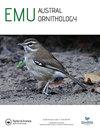Comparative nest attendance and chick provisioning strategies in coastal and desert nesting Grey Gulls (Leucophaeus modestus) in northern Chile
IF 1.1
4区 生物学
Q3 ORNITHOLOGY
引用次数: 0
Abstract
ABSTRACT Grey Gulls (Leucophaeus modestus) are unique among gulls in that they forage in the coast but breed up to 115 km inland in the barren Atacama Desert of northern Chile. By nesting in the desert, adults are limited to a single daily foraging trip to feed their chicks and relieve their incubating/brooding mates. Birds perform long-distance and energetically expensive trips between foraging and breeding grounds. We describe how Grey Gulls modify nest attendance and chick provisioning strategies from an unusual coastal colony established at Playa Brava, northern Chile, during the 2017–2018 season. Contrary to what it is usually observed in desert colonies, incubating, and brooding Grey Gulls at Playa Brava relieved mates at the nest regularly and fed chicks several times throughout the day. Some adults even left their chicks unattended at the nest to forage on the nearby shoreline (<0.15 km) for a variable amount of time (up to 57 min) before returning to resume brooding. These behaviours are likely to ease parental duties by allowing multiple pair changeovers, reduce energy expenditure by avoiding extensive trips between the desert and the coast, increase chick growth rates by allowing multiple meals during the day, among other advantages. Our observations show that, when moving their colonies from the desert to the coast, Grey Gulls accordingly adjust their breeding behaviour to cope with this new habitat.智利北部沿海和沙漠筑巢灰鸥(Leucophaeus modestus)的巢率和雏鸟供应策略比较
灰鸥(Leucophaeus modestus)在海鸥中是独一无二的,因为它们在海岸觅食,但在智利北部贫瘠的阿塔卡马沙漠内陆115公里处繁殖。通过在沙漠中筑巢,成年鸟每天只能去一次觅食,喂养它们的雏鸟,并缓解它们正在孵化/孵蛋的配偶的压力。鸟类在觅食地和繁殖地之间进行长途飞行,耗费大量能量。我们描述了2017-2018年期间,在智利北部普拉亚布拉瓦建立的一个不寻常的沿海殖民地,灰鸥如何改变筑巢率和雏鸟供应策略。与通常在沙漠栖息地观察到的情况相反,普拉亚布拉瓦的孵化和孵化的灰鸥会定期在巢中释放配偶,并在一天中多次喂养雏鸟。有些成鸟甚至把雏鸟留在巢内无人看管,到附近的海岸线(<0.15公里)觅食,时间不等(最多57分钟),然后再回来继续孵蛋。这些行为可能通过允许多次配对交换来减轻父母的责任,通过避免在沙漠和海岸之间的长途旅行来减少能量消耗,通过允许一天多餐来提高雏鸟的生长速度,以及其他好处。我们的观察表明,当灰鸥将它们的栖息地从沙漠迁移到海岸时,它们相应地调整了它们的繁殖行为,以适应这个新的栖息地。
本文章由计算机程序翻译,如有差异,请以英文原文为准。
求助全文
约1分钟内获得全文
求助全文
来源期刊

Emu-Austral Ornithology
生物-鸟类学
CiteScore
2.00
自引率
7.70%
发文量
33
审稿时长
>12 weeks
期刊介绍:
Emu – Austral Ornithology is the premier journal for ornithological research and reviews related to the Southern Hemisphere and adjacent tropics. The journal has a long and proud tradition of publishing articles on many aspects of the biology of birds, particularly their conservation and management.
 求助内容:
求助内容: 应助结果提醒方式:
应助结果提醒方式:


